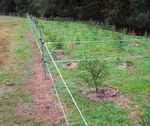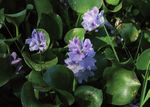Platypus - Land for Wildlife
←
→
Page content transcription
If your browser does not render page correctly, please read the page content below
Land for Wildlife Queensland: Note A5
Platypus
M any have been lucky enough
to have seen a Platypus
(Ornithorhynchus anatinus), or have
They are truly remarkable animals, whose presence in a healthy breeding
population is an indicator of good water quality and aquatic habitat. This Note
provides an overview of Platypus ecology and identifies factors that pose a threat to
at least thought that those ripples on their survival. Platypus are one of two species of monotreme (egg-laying mammals)
the surface of the water may have found in Australia, the other being the Short-beaked Echidna.
been one.
Where are Platypus found?
Platypus are widespread and found in permanent streams, rivers and lakes from
North Queensland to Tasmania. They may also use temporary, or artificial water
bodies (e.g. dams), particularly when these are linked to streams or rivers. Platypus
are not often seen because of their quiet, retiring nature and largely nocturnal
habits (you are most likely to see Platypus at dawn or dusk). Whilst Platypus are not
listed as threatened, they are vulnerable to local extinctions if waterways are not
managed properly. It is important to note that all native wildlife is protected under
the Nature Conservation Act 1992.
Within Queensland, Platypus have been reported in many east-flowing rivers
between Cooktown and the NSW border and the headwaters of three of the five
river systems draining into the Murray-Darling Basin. They are still common in
parts of the Atherton Tablelands but do not appear to occupy any of the waterways
flowing into the Gulf of Carpentaria. Platypus are reasonably abundant in South
East Queensland, even in more urbanised areas where habitat remains suitable.
Platypus spend most of the day
asleep in their burrows but come out
Platypus to feed at dawn and dusk. Photo by
distribution in Stefan Kraft, Wikimedia Commons.
Queensland.
High quality Platypus habitat.
Photo by Nick Clancy.Platypus Facts
Lifespan and breeding
Platypus have been recorded to live to the age of 16 years
in the wild; however, most die at a younger age, possibly
4-5 years for males and 6-8 years for females. They breed
from about July to September. Females lay 1-3 eggs that
are incubated between her belly and curled up tail. Female
Platypus lack nipples, instead their milk oozes out through
ducts on their abdomen. The eggs are very small (15-18 mm)
and after hatching, the juveniles are fed milk for about four
months. Adult male Platypus measure an average 50 cm in
length (bill to tail) and weigh 1.2-2.6 kg. Adult females are
slightly smaller, measuring an average 44 cm in length and Crustaceans such as yabbies are an important
weighing 0.6-1.6 kg. food source for Platypus.
Diet
Platypus consume 15-30% of their body weight in food
each day. Their diet includes a wide variety of freshwater
invertebrates including shrimps, water insects, worms
and mussels. They may also incidentally ingest tadpoles,
small frogs, fish and their eggs. Platypus protect their eyes
and ears by automatically closing them underwater. To
detect prey, their bills are equipped with electroreceptors
that sense the tiny electrical currents created when their
prey moves. Platypus usually remain underwater for
approximately a minute, returning to the surface to chew
their food with the rough grinding pads they have instead of
teeth.
Riffles (shallow, pebbly sections of rivers and creeks)
are important feeding sites for Platypus, as they eat
invertebrates that hide in amongst the pebbles.
Spurs
Information on the sex and age of Platypus can be gained
by examining the appearance of a spur located on the inner
ankle of the hind foot. Juvenile males are equipped with a
cone-shaped spur about one cm long. The spur is covered
with a white chalky layer, which chips away by the age of
about nine months to reveal the ‘true’ spur. Male Platypus
start producing poison at two years of age. Young female
Platypus have tiny (1-2 mm long) white or brown spurs,
which are shed around the age of 8-10 months. People
who are spurred when handling male Platypus typically
experience severe pain and swelling, although the poison is Riffles (shallow, pebbly sections of rivers and creeks)
not considered to be life-threatening. provide important foraging sites for Platypus.
Photo by Nick Clancy.Burrows Threats to Platypus
Platypus may spend up to 17 hours a day asleep in Platypus have natural predators such as goannas and Wedge-tailed
burrows. There are two types of burrows, nursery/ Eagles. Introduced species such as foxes, domestic dogs and cats
nesting burrows (providing shelter for a mother can also prey on Platypus. Other threats to Platypus resulting from
and her offspring) and camping/resting burrows. human activity include:
Nesting burrows are 3-15 metres long, with one • Decreased stream flow due to dam construction and drainage
or more entrances located above the waterline. works.
Camping burrows are only 1-3 metres long with • Pumping water from creeks.
entrances usually located underwater. River and • Entanglement in fencing wire and litter.
creek banks must be stable with overhanging
• Vegetation clearing.
streamside vegetation which provides secure
• Home and agricultural chemical pollutants such as pesticides,
burrows and protection for their entrances.
fertilisers, detergents and urban stormwater.
• Disturbance to banks from activities such as heavy machinery or
vehicle use, which can cause burrows to collapse.
• The spread of water weeds that can choke waterways and
prevent Platypus from swimming, feeding and digging burrows.
Water pollution
Rubbish dumped in watercourses may cause severe injury or
death to Platypus such as fishing line, barbed wire fencing or PVC
pipe. Chemical pollutants (e.g. oils, paints, pesticides) that enter
freshwater systems through runoff can harm Platypus by fouling
the water, thereby poisoning or killing the animals on which they
feed. Unmanaged livestock access to creeks and rivers can also
damage nesting burrows through erosion and compaction. Limiting
livestock access to watercourses and banks will conserve your
water source for Platypus and will maintain water quality and
protect vegetation cover. Healthy streamside vegetation will help
prevent bank erosion and subsequent siltation which can have
Riparian revegetation works can improve Platypus significant effects on the animals that Platypus feed on.
habitat by providing buffers to streams and filtering
overland water flows. Photo by Nick Clancy. Weeds
Exotic pasture grasses like Para Grass (Brachiara mutica) and water
weeds such as Water Hyacinth (Eichornia crassipes) can choke
water flow and impede the movement of native animals. Avoid
unnecessary disturbance to the roots and soil when controlling
weed trees (e.g. willows and Camphor Laurel) and shrubs. The ‘cut
stump’ or ‘stem injection’ methods, which leave the roots in place
but kill the tree, are preferable (see Land for Wildlife Note EW2 -
Weed Control Methods).
Feral animals and domestic pets
Domestic pets and foxes are considered major predators of
Platypus. It is therefore important to prevent pets from wandering
along waterways, especially at night. Walking paths or vehicle
tracks along the edge of water courses can facilitate access by
predators such as foxes and dogs and contribute toward erosion
and damage to Platypus burrows.
Aquatic weeds such as Water Hyacinth can restrict
the movement of native animals including Platypus.
Note A5: PlatypusPlatypus care What you can do
PlatypusCare was established by the Australian Platypus Maintain, restore or improve the quality of native
Conservancy in 2002. In 2004, the Wildlife Preservation riparian vegetation.
Society of Queensland (WPSQ) became a collaborator Restrict livestock access to watercourses and banks
when they started Queensland PlatypusCare. The main and install off-stream watering points.
objectives are to raise public awareness about the
Control weeds and prevent the introduction and
Platypus, its habitat and to collect reliable data on their
spread of new weeds.
distribution and abundance in Queensland.
Retain or install logs, stumps and snags (large
This data is then provided to local and state planning woody debris) in and along watercourses.
authorities with the aim of improving land and Avoid placing walking paths or vehicle tracks along
catchment management practices for Platypus. If you the edge of watercourses.
would like more information on the program, or have a
Carefully dispose of fishing line and sharp or jagged
Platypus record to submit, you can visit the webpage for
objects such as fish hooks and barbed wire.
the Australian Platypus Conservancy at www.platypus.
asn.au or WPSQ: www.wildlife.org.au and click on the Avoid placing barbed wire fences across creek-
Platypus icon, or email: platypus@wildlife.org.au, lines.
or phone WPSQ on 3221 0194. Restrain or confine domestic pets at night time.
Prepare a property management plan which
Other relevant notes includes wildlife conservation.
Land for Wildlife Note W1 – Riparian Management and Cover pumps with a grille or mesh cover to prevent
Restoration. Platypus being sucked into intake pipes.
Land for Wildlife Note G4 – Wildlife Friendly Fencing Avoid using ‘Opera House’ style yabby traps as
and Netting. these can trap and kill Platypus.
Land for Wildlife Note G5 – Responsible Pet Ownership. Remember a healthy creek for Platypus will be a
Land for Wildlife Note EW2 – Weed Control Methods. healthy creek for aquatic invertebrates and therefore,
all other creatures in the freshwater food chain.
Platypus are indicators of good environmental
health of waterways as they depend on healthy
streambanks for making their burrows and a
range of freshwater invertebrates for food.
Land for Wildlife is a voluntary program that encourages and assists landholders to provide habitat for wildlife on their properties. For more
information about Land for Wildlife South East Queensland, or to download Land for Wildlife Notes free of charge, visit www.lfwseq.com.au
Citation: Land for Wildlife Queensland (2011) Note A5: Platypus.
Information in Land for Wildlife Notes is not necessarily endorsed by any of the supporting agencies, nor should it be taken to constitute
professional advice or a recommendation of land management.
Land for Wildlife Notes are developed and funded by the Local Governments delivering the LfWSEQ program shown below. Reprinted in 2022.You can also read



























































